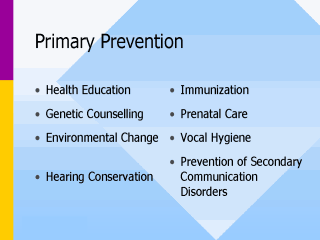| front |1 |2 |3 |4 |5 |6 |7 |8 |9 |10 |11 |12 |13 |14 |15 |16 |17 |18 |19 |20 |review |
 |
Examples of
Primary Prevention: A. Health Education: programs to increase public awareness, promoting change in behaviors or attitudes (e.g., danger of alcohol and drug use during pregnancy). B. Genetic Counseling: education of those individuals at risk for genetic disorders. C. Environmental Change: alteration of the environment to decrease the risk of occurrence (e.g., decreasing noise exposure). D. Vocal Hygiene: programs targeting prevention of voice disorders (e.g. activities designed to prevent vocal abuse and nodules or stop the use of smoking and smokeless tobacco products). E. Hearing Conservation: programs related to the prevention of noise-induced hearing loss (e.g. promoting the use of work-site hearing protection and instituting school- and community-based hearing conservation programs). F. Immunization: shots that provide antigens to resist various diseases (e.g. Rubella). G. Prenatal Care: provision of prenatal care to significantly decrease the incidence of birth defects and complications due to problems during pregnancy. H. Primary Prevention of Secondary Communication Disorders: prevention of a secondary communication disorder due to an existing primary disability (e.g. prevention of speech-language disorder in a low birth weight baby). Transition Point: As previously defined, secondary prevention refers to early identification and preventive intervention of a disease or disorder…. |